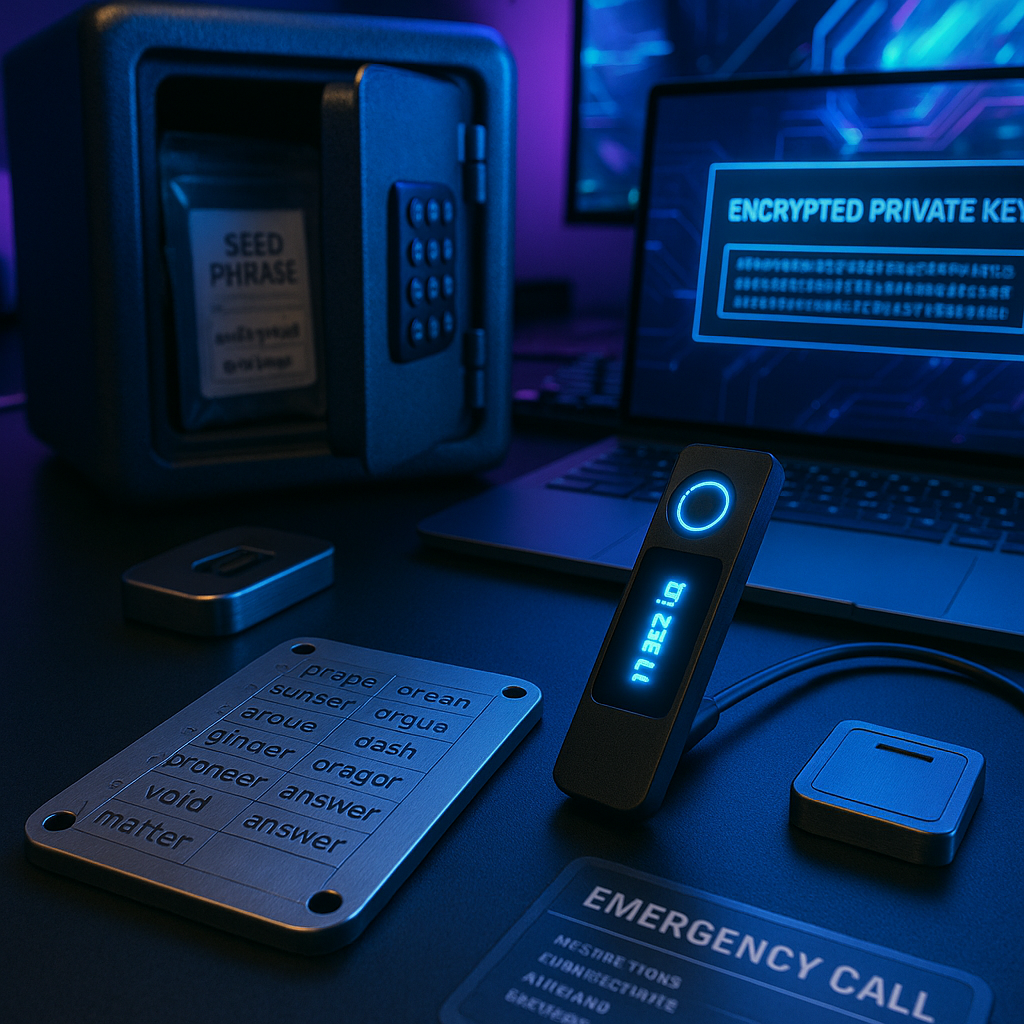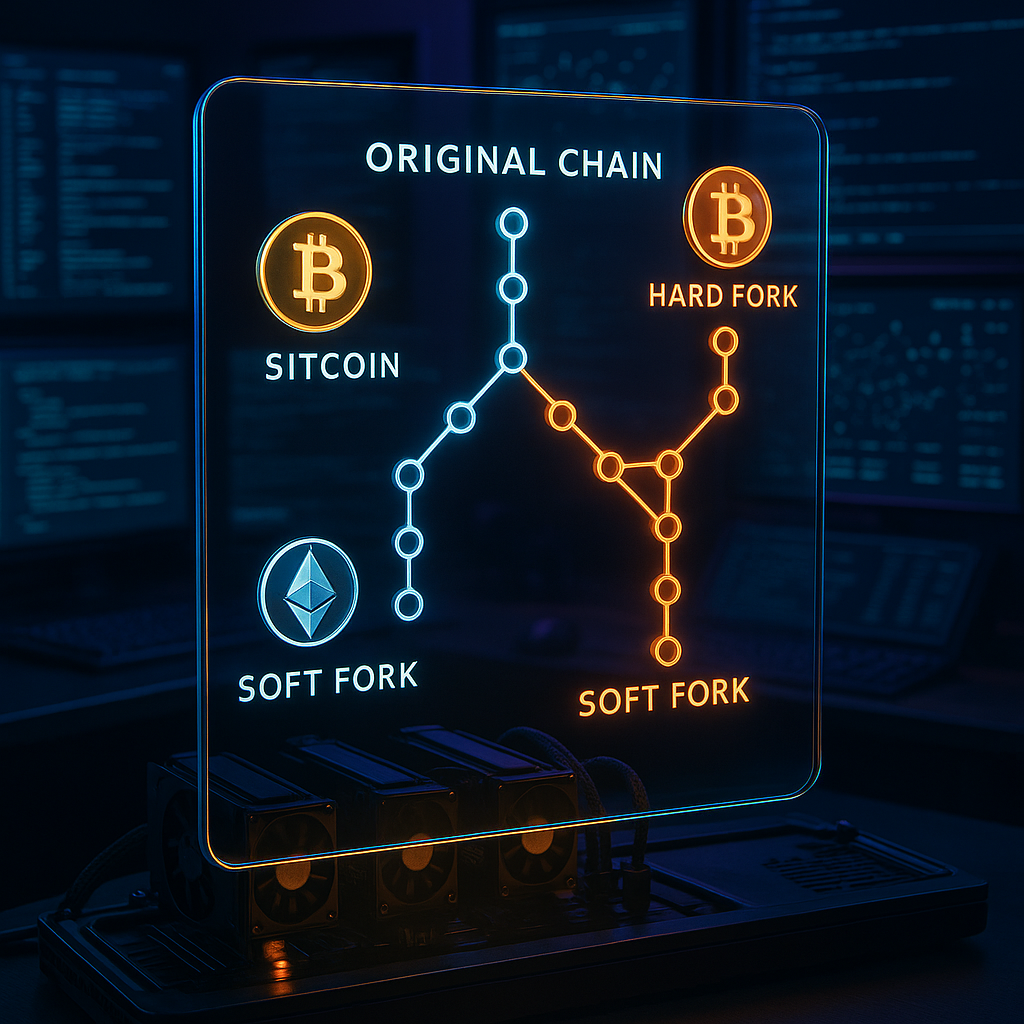Key Takeaways
- Master your keys: Private keys equal ownership.
A private key is a unique cryptographic code that directly grants access to your cryptocurrency. Whoever holds it, controls the coins. This highlights why safeguarding it is crucial for crypto asset protection. - Seed phrases: Your all-in-one recovery safeguard.
A seed phrase is a set of common words that acts as the master backup for your entire crypto wallet. With it, you can restore all linked private keys, making it your ultimate tool for recovering lost access. - Absolute confidentiality and secure storage are essential.
Both private keys and seed phrases must remain confidential. Store them securely offline whenever possible to guard against hacks, phishing, or accidental disclosure. - Seed phrase is not a password: Total access at stake.
Unlike a typical password, a seed phrase grants full control over your wallet. If someone else acquires it, your entire wallet (and all associated funds) is at risk, so handle it with exceptional care. - Wallets rely on both for layered security.
Crypto wallets generate private keys from your seed phrase, using both to manage your accounts. A strong grasp of their operation is essential for wallet use and recovery. - DIY defense: Use paper, hardware wallets, or encrypted backups.
The best practice is to handwrite your seed phrase (never store digitally) or protect it using a reputable hardware wallet or a secure, encrypted backup. - No second chances: Irreversible consequences for mistakes.
Crypto transactions cannot be reversed. If your private key or seed phrase falls into the wrong hands, your assets are irretrievable. Proactive, careful security habits are non-negotiable.
With these core principles in mind, you are better prepared to venture into the world of cryptocurrency with confidence. The following sections will clarify how these security tools function, outline practical storage tips, and help you avoid common mistakes that can jeopardize your digital assets.
Introduction
Entering the world of cryptocurrency offers unique opportunities, but it also introduces new forms of risk. Losing access to your crypto wallet is not a minor setback. It can result in the permanent forfeiture of your investment. Understanding the difference between a private key and a seed phrase is far more than learning technical language; it is the line between complete control and total vulnerability over your crypto assets.
Knowing how private keys operate as proof of digital ownership, and why seed phrases are considered your ultimate recovery backup, equips you to shield your digital wealth from hackers, loss, and avoidable mistakes. Secure handling, strict confidentiality, and a clear understanding of these foundations form the backbone of crypto safety for every newcomer.
Let’s break down the essentials of crypto security, take a close look at trusted storage methods, and make sure you’ve got the practical tools to avoid costly beginner mistakes.
Stay Sharp. Stay Ahead.
Join our Telegram Group for exclusive content, real insights,
engage with us and other members and get access to
insider updates, early news and top insights.
 Join the Group
Join the Group
Private Key vs Seed Phrase: Core Concepts
A private key is the cornerstone of cryptocurrency security. It is a highly secure digital signature that serves as the single access point to your crypto holdings. Structured as a long combination of numbers and letters (commonly 256 bits in length), this string grants absolute control over the funds in your wallet. You can think of your private key as the only key to a digital vault. Possessing it means owning everything inside.
For example, a private key may look like:
5KQwrPbwdL6PhXujxW37FSSQZ1JiwsST4cqQzDeyXtP79zkvFD3
Seed phrases (often called recovery phrases or mnemonic phrases) provide a more user-friendly way to manage wallet backup and recovery. A seed phrase consists of 12 or 24 ordinary words in a specific sequence. Instead of wrestling with complex cryptographic codes, users can record these words for safekeeping.
A typical 12-word seed phrase might look like:
maple dog sunset ocean brave mountain journey pencil laptop canvas river sugar
Key Differences and Relationships
Understanding the relationship between private keys and seed phrases is essential. A single seed phrase can generate a suite of private keys for multiple wallets and addresses. This structure brings several important advantages:
- Single Backup Solution: One seed phrase can restore all related accounts and wallets, streamlining recovery processes across multiple platforms.
- Enhanced Security: The seed phrase itself remains hidden during everyday use and is never broadcast to the blockchain network.
- Streamlined Recovery: The use of common words simplifies backup storage and transcription, minimizing human error when recording or verifying recoveries.
Seed phrases act as a master recovery mechanism for your wallets, while private keys authenticate individual transactions and manage asset access. Both are vital, just with different roles and vulnerabilities.
Why Secure Storage Is Non-Negotiable
Protecting your private keys and seed phrases is not just best practice. It is a fundamental requirement for participating in the crypto world. Accidental leaks or theft can have devastating consequences. According to a 2018 Chainalysis report, nearly 20% of all Bitcoin in existence (worth billions of dollars) is presumed lost forever due to mismanaged private keys.
Common Attack Vectors
Being aware of common threats helps you build stronger defenses:
- Digital Theft:
- Malicious software that scans computers for unencrypted private key files or seed backups
- Phishing scams designed to trick users into revealing their seed phrases
- Compromised password managers or cloud storage accounts holding sensitive information
- Physical Vulnerabilities:
- Careless storage of written seed phrases, leaving them accessible to unauthorized individuals
- Physical damage, such as fire, water, or deterioration, impacting paper or digital backups
- Theft or misplacement of unsecured hardware wallets or physical backups
Because cryptocurrency is non-custodial and decentralized, there is no central authority to restore lost access. Losing your keys or seed phrase usually results in permanent loss.
Security isn’t a one-time setup. It needs regular attention and adaptation, kind of like locking your door every night — you just get in the habit.
Practical Strategies for Secure Storage
Keeping your crypto credentials safe requires thoughtful, layered strategies. Here are several best practices:
Digital Security Measures
Hardware Wallets:
- Choose reliable brands (Ledger, Trezor, for example) to store private keys and execute transactions.
- Regularly update your device firmware to fix bugs and vulnerabilities.
- Store your hardware wallet in a locked, fire-resistant safe or another secure location.
Air-Gapped Storage:
- Generate and back up seed phrases on computers that never go online.
- Use encrypted USB drives for digital backups, making sure these devices are only used offline.
- Store several backup copies in different (and ideally distant) secure places to avoid loss from a fire or other disaster.
Physical Storage Solutions
Metal Storage:
- Etch or stamp your seed phrase onto fireproof, waterproof metal backup plates (like Cryptosteel or Billfodl).
- Store fragments of your seed phrase in separate locations to reduce risk from theft or disasters.
Paper Backup Protocol:
- Write the seed phrase by hand with permanent ink — skip the printer, which isn’t as secure.
- Seal the paper backup in a laminated or waterproof envelope to avoid water damage or fading.
- Store copies in multiple, secure, and separate spots (like a safe deposit box or a home safe).
- For extra safety, split your seed phrase into segments, each one stored in a different location. That way, even if one is found, your whole phrase isn’t compromised.
Critical Crypto Security Habits
Strong, consistent habits protect you better than any single piece of technology.
Stay Sharp. Stay Ahead.
Join our Telegram Group for exclusive content, real insights,
engage with us and other members and get access to
insider updates, early news and top insights.
 Join the Group
Join the Group
Daily Security Practices
- Regular Verification: Check every backup (paper, metal, digital) at least monthly. Is it still there, still legible?
- Protocol Updates: Every three months or so, reassess your security setup and tweak it if new risks have emerged or if there are better tools available.
- Recovery Drills: Occasionally practice restoring your wallet from backup. Make sure it all works — don’t just assume.
- Condition Monitoring: Watch for risks like heat, moisture, or other hazards where you store backups. A moldy safe is a bad surprise.
Emergency Response Plan
It pays to have a plan for “what if?” scenarios — that way you can move fast before an issue spirals.
- Immediate Actions if Compromised:
- Move your funds as quickly as possible to a new, uncompromised wallet.
- Keep detailed notes about what happened in case you need to explain it later or analyze the breach.
- If your assets are on an exchange, get in touch with their customer support pronto.
- Generate new keys and seed phrases, and update all backups immediately.
- Prevention Measures:
- Don’t store seed phrases or keys digitally unless fully encrypted and kept offline.
- Never share recovery details through online messages or with anyone you don’t absolutely trust.
- Use a unique, randomly generated seed phrase for each wallet to prevent cross-wallet risk.
- For larger sums, set up multi-signature wallets so several approvals are needed for transactions.
FAQs Section
Can I change my seed phrase?
Seed phrases are set in stone for each wallet. To “change” one, you must create a new wallet (with a fresh seed phrase) and transfer your assets over.
What if I lose one word of my seed phrase?
Sometimes a specialist can recover a phrase missing just one word, but it’s risky and success isn’t guaranteed. Best to always keep a full, accurate backup.
Should I use a password manager for my seed phrase?
Not really a good idea. Password managers are great in general, but if one gets hacked, your recovery phrase could be exposed. Physical, offline methods tend to be safer for this level of sensitive information.
How many copies of my seed phrase should I keep?
Two or three backup copies, each in a different secure location, is enough for most people. Spread out the locations so a single disaster — fire, flood, theft — doesn’t wipe everything out.
Can someone guess my private key?
That’s as likely as winning the lottery a billion times in a row. The 256-bit length offers so many possible combinations it’s beyond the reach of current technology or even what’s possible in the universe — literally more than atoms in the cosmos.
Conclusion
Mastering private keys and seed phrases is the foundation for safe and confident crypto participation. If you grasp how each one works (and how either can be lost or stolen), you’re already taking control of your digital assets. Sure, hardware wallets, disconnected computers, and shiny metal plates help a ton. But at the end of the day, it’s your routines and habits — your willingness to actually double-check, update, and test your recovery steps — that make you the real vault. Crypto puts real power (and responsibility) in your hands. There’s no backstop, no “forgot password” option, no one you can call for a do-over. Make your security airtight, keep practicing your backup routine, and stay on top of new risks as they pop up. If you do, crypto doesn’t have to be a leap into the unknown. With the right knowledge and steady habits, you’ll have the keys (literally and figuratively) to move forward, unlock new opportunities, and keep your assets safe in the wild world of digital money.





Leave a Reply